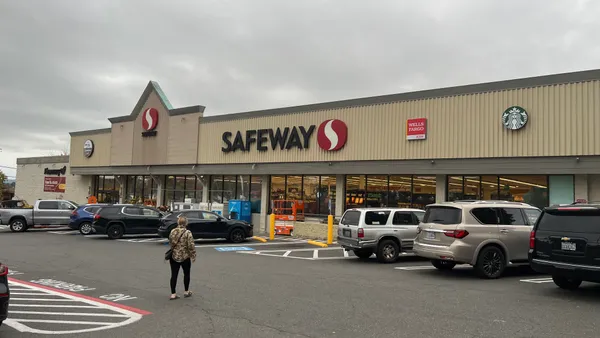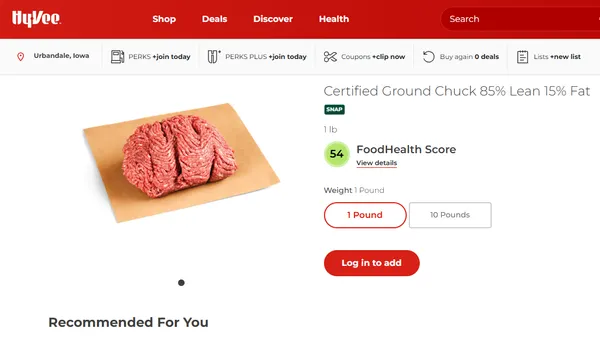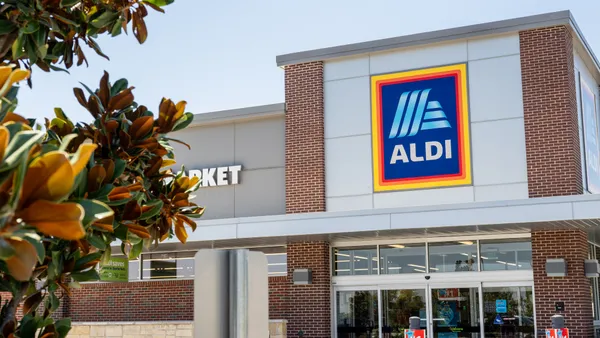UPDATE: June 17, 2019: Delivery Unlimited is currently available in four cities, company spokeswoman Molly Blakeman told Grocery Dive: Houston, Miami, Salt Lake City and Tampa, Florida. She said the company is "constantly testing new concepts" to improve its pickup and delivery service.
Dive Brief:
- Walmart is now offering an unlimited grocery delivery plan for shoppers, according to TechCrunch. Delivery Unlimited is available for $98 a year or $12.95 a month and includes the full assortment of grocery products. There is a $30 minimum for all Walmart Grocery orders.
- It’s unclear when Walmart began piloting Delivery Unlimited and how many markets currently offer it. Grocery Dive has reached out to Walmart for details but had not heard back as of press time.
- Delivery Unlimited is a third grocery e-commerce buying option offered by Walmart. Shoppers can pick up orders for free at nearly 3,000 stores or pay $9.95 per order for delivery from around 1,000 locations. To promote its new unlimited service, Walmart is offering a free 15-day trial in markets where it's available, according to TechCrunch.
Dive Insight:
Walmart's standard $10 delivery service fee coupled with a $30 order minimum makes economic sense for the retailer, and it promotes the sort of stock-up shopping trip that a lot of its customers like to do.
But $10 per order can add up over time for the retailer's customers, many of whom are on a limited budget. Walmart needs a membership option to bring more people over to the fast-growing service, and for the retailer to compete with the likes of Instacart, Shipt and Amazon, all of which have recently made changes to their membership plans.
Target-owned Shipt, which topped a recent Consumer Reports poll for customer satisfaction, just expanded its same-day delivery availability by adding a $10-per-order option for nonmember customers, in addition to its $98 annual plan. That move was essentially the inverse of what Walmart is doing with Delivery Unlimited, though the common thread is that both companies are casting a wider net to reach delivery-curious customers. Late last year, Instacart slashed its delivery membership fee from $149 down to $99 and cut one-time delivery fees nearly in half. Amazon raised its Prime membership fee by $20 last year, though the service offers much more than grocery delivery from Whole Foods stores, Prime Now and through AmazonFresh.
Delivery fees are one of the main barriers keeping shoppers from adopting grocery e-commerce. As companies lower these fees, they're inviting more customers in but also making it harder to turn a profit, given the high costs of last-mile fulfillment. Walmart currently uses third-party companies like DoorDash and Roadie to ferry groceries from its stores to shoppers' homes.
According to a Bain & Co. survey published in February, just one-quarter of U.S. consumers had tried an online grocery service over the past year. As companies bring down fees and increase convenience, though, the firm expects home delivery will "explode" in the coming years.
Walmart will need to see a major boost in adoption to justify a nationwide expansion of Delivery Unlimited. The retailer's free pickup service has so far proven to be a money maker for the company, boosting e-commerce sales and bringing in valuable new customers. But the value of same-day delivery for the company is still unclear at this point.
The company is investing in drone delivery, automation and other innovations that promise to reduce the cost of home delivery. It's also upping the ante on convenience by rolling out an in-home delivery service where employees actually stock customers' fridges. InHome Delivery will be available to nearly 1 million customers in three markets beginning this fall.











